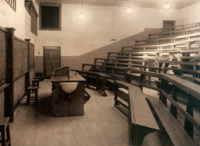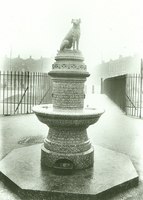Items
Site
The Medicine Chest
keywords is exactly
lecture
-

Page 65 of the Curiosity CLXXV catalogue
Page 65 of the 'Curiosity CLXXV' catalogue, showing the Old Anatomy Lecture Theatre (currently part of the Centre for Curating the Archive). -

'How Zoology was taught in the past'
The wall text accompanying these charts in the Hunterian museum, Glasgow, reads: "In the late 19th and 20th centuries, before the advent of colour slides that could be projected, the teaching of Zoology depended heavily on the use of wall charts to illustrate lectures. They were hung on a special pulley system at the front of the lecture theatre and, because of their large size, could be clearly seen from the back of the class". -

The Brown Dog Affair (1903 - 1910)
On Feb. 2, 1903, English physicians William Bayliss and Ernest Starling, gave a lecture on the digestive system to a theatre full of medical students. Also in attendance were Lizzy Lind af Hageby and Leisa Schartau, committed feminists and anti-vivisectionists. They had travelled from Sweden to enrol at the London School of Medicine for Women, attend lectures around town, and document the practice of vivisection in British universities. During the lecture, a brown terrier was wheeled out, strapped to a board. Starling had already performed one experiment on the dog two months earlier, shutting off its pancreas. This time, Bayliss cut open the dog’s neck and spent half an hour unsuccessfully trying to stimulate the animal’s salivary glands with electrodes. Eventually, he gave up and handed the dog over to a student (Henry Dale, another future Nobel laureate) who stabbed it through the heart, thus ending the lesson. What followed was a court case filed by Stephen Coleridge, a prominent barrister and secretary of the National Anti-Vivisection Society against Bayliss. After four days of testimony, the judge called the women’s account “hysterical” while giving instructions to the jury. The jurors conferred for 20 minutes, then found Coleridge guilty of libel. Anti-vivisectionists commissioned a bronze statue of the dog as a memorial, unveiled in Battersea in 1906. Its plague, which read "Men and women of England, how long shall these Things be?" led to the it being vandalised on a frequent basis. On 10 December 1907, hundreds of medical students marched through central London waving effigies of the brown dog on sticks, clashing with suffragettes, trade unionists and 300 police officers, one of a series of battles known as the ‘Brown Dog’ riots. In March 1910, tired of the controversy, Battersea Council sent four workers accompanied by 120 police officers to remove the statue under cover of darkness, after which it was reportedly melted down by the council's blacksmith. -

175 chalk-board dusters
For the exhibition, 'Curiosity CLXXV', the curators took an old duster from each teaching venue and replaced it with a new one.


